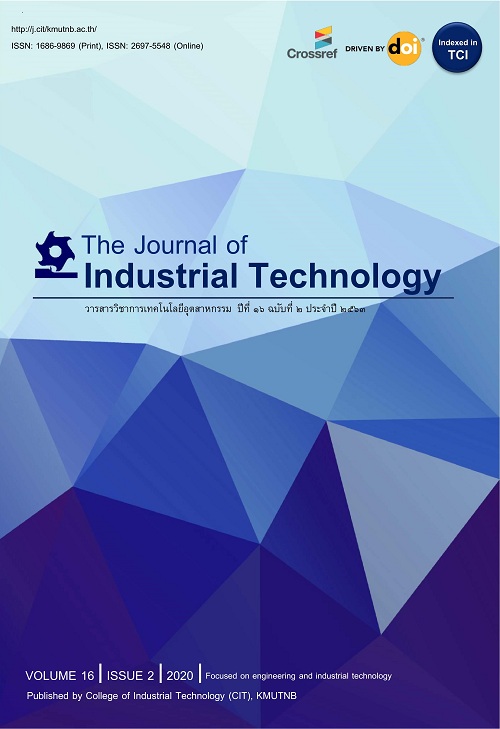Removal of Methylene Blue Dye using Local Adsorbent Materials
การกำจัดสีย้อมเมทิลีนบลูโดยใช้วัสดุดูดซับในท้องถิ่น
Abstract
งานวิจัยนี้มีวัตถุประสงค์เพื่อเปรียบเทียบความสามารถในการกำจัดสีย้อมเมทิลีนบลูด้วยวัสดุดูดซับ 3 ชนิดได้แก่ ถ่านกัมมันต์ ถ่านหุงต้ม และถ่านจากไม้ไผ่ โดยทำการศึกษาปัจจัยที่มีผลต่อการดูดซับสีย้อมเมทิลีนบลูได้แก่ ปริมาณวัสดุดูดซับ (0.5-2.0g) ระยะเวลาที่ใช้ในการดูดซับ (0-120min) ความเข้มข้นของสีย้อมเมทิลีนบลู (65-140mg/L) และค่าพีเอช (3-9) และศึกษาความสามารถในการดูดซับด้วยสมการไอโซเทอมของแลงเมียร์และฟรุนดิช จากการศึกษา พบว่า วัสดุดูดซับทั้ง 3 ชนิด มีปริมาณ และระยะเวลาที่เหมาะสม เท่ากับ 2g และ 90min ตามลำดับ สำหรับประสิทธิภาพการกำจัดสีย้อมเมทิลีนบลูของถ่านกัมมันต์ ถ่านหุงต้มและถ่านไม้ไผ่ มีค่าเท่ากับ 75.48 23.90 และ 16.57% ตามลำดับ จากการศึกษาไอโซเทอม พบว่า กลไกการดูดซับของวัสดุดูดซับทั้ง 3 ชนิดสอดคล้องกับสมการ Langmuir โดยมีค่าความสามารถในการดูดซับสูงสุดเท่ากับ 18.73 5.18 และ 0.81mg/g ตามลำดับ เมื่อพิจารณาความสามารถในการดูดซับสูงสุดต่อพื้นที่ผิวในการดูดซับของถ่านแต่ละชนิด พบว่า ถ่านหุงต้มมีค่าสูงที่สุด รองลงมาถ่านไม้ไผ่ และ ถ่านกัมมันต์ ตามลำดับ ถ้าพิจารณาความคุ้มค่าทางเศรษฐศาสตร์ ถ่านหุงต้มมีราคาถูกที่สุด ดังนั้น ถ่านหุงต้มจึงเป็นวัสดุดูดซับในท้องถิ่นที่เหมาะสมสามารถนำมาใช้ในการกำจัดสีย้อมเมทิลลีนบลู
The objective of this study is to compare methylene blue dye removal ability by 3 types of adsorbent materials including activated carbon, charcoal and bamboo charcoal. The effects of adsorbent dosage (0.5-2.0 g), contact time (0-120 min), initial methylene blue concentration (65-140 mg/g) and pH solution (3-9) were investigated. The adsorption isotherms were analyzed by using Langmuir and Freundlich equations. The experimental results found that the optimum adsorbent dosage and contact time of the low-cost adsorbents were 2 g and 90 min, respectively. The removal efficiencies of methylene blue by activated carbon, charcoal and bamboo charcoal were 75.48, 23.90 and 16.57 %, respectively. Adsorption data were fit to Langmuir isotherm model. The maximum adsorption capacities of activated carbon, charcoal and bamboo charcoal were 18.73, 5.18 and 0.81 mg/g, respectively. When considering the maximum adsorption capacity per adsorption surface area of each adsorbent material, it was found that the charcoal had the highest value followed by bamboo charcoal and activated carbon respectively. If considering the economic value charcoal is the cheapest. Therefore, charcoal was the suitable local absorbent material which can be used for methylene blue dye removal.
Keywords
[1] T.W. Seow and C.K. Lim, Removal of dye by adsorption: A review, International Journal of Applied Engineering Research, 2016, 11(4), 2675-2679.
[2] P. Sae-ui, T. Kongkaew, T. Wongsuk, T. Watcharamai and K. Sombatsompop, Adsorption of methylene blue dye by zeolite Na-A and standard Zeolite 4A, The Journal of Applied Science, 2019, 18(2), 51-63. (in Thai)
[3] C. Kahapana and N. Phowan, A study on adsorption efficiency of methylene blue dye using adsorbent material prepared from water Hyacinth, SWU Engineering Journal, 2020, 15(2), 58-70.
[4] W. Sangarunlert, Adsorption of methyl red dye by activated carbon from egg shell and ark shell by chemical activation method, Science and Technology Nakhon Sawan Rajabhat University Journal, 2015, 7(7) 97-110.
[5] E. Misran, O. Bani, E.M. Situmeang and A.S. Purba, Banana stem based activated carbon as a low-cost adsorbent for methylene blue removal: Isotherm, kinetics, and reusability, Alexandria Engineering Journal, 2021. (Article in press)
[6] K. Kliangpradith, N. Thongmak and P. Sridang, Adsorption of organic substance and dyestuff from batik textiles wastewater by rubber wood fly ash, The Journal of Industrial Technology, 2021, 17(1), 1-14. (in Thai)
DOI: 10.14416/j.ind.tech.2021.09.002
Refbacks
- There are currently no refbacks.






